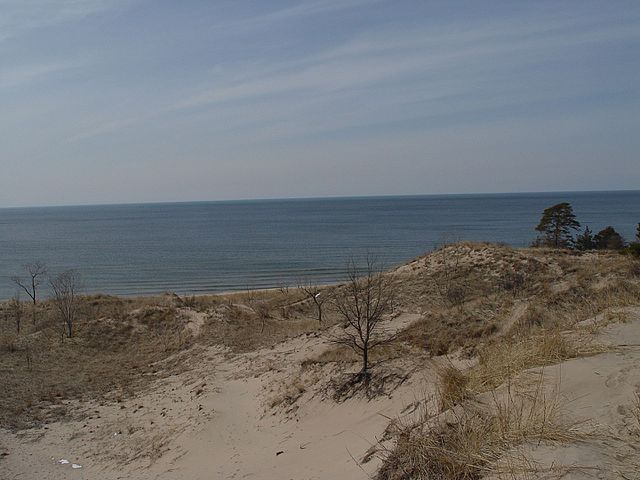With Great Lakes water levels set to go to new highs this summer, and the spectacle of more beach homes toppling into the lakes, we’re now being subjected to the inevitable photo ops and speech making from politicians promising to just do something about it.
Sen. Debbie Stabenow (D-Mich.) puts the blame on global warming. “The biggest problem is that we should’ve been acting earlier on the question of how the atmosphere is changing and holding more precipitation, and all the flooding issues and everything that’s happening as a result of the climate crisis,” she said in a visit to a Lake Michigan beach on Friday. “We have to respond. I believe in science.”
What she didn’t say, and what most everyone knows, is that coming up with an engineering fix for Great Lakes water levels, let alone a global fix for the Earth’s atmosphere, will take hundreds of billions of dollars, many years, and massive political coordination in the United States and Canada — two nations that have spent decades working out diplomatic and environmental approaches to managing the water. What’s more, there is a debate underway among scientists about how much the lake levels are a function of natural variability — they were at historic lows as recently as 2014 — and how much of it is driven by climate factors. But Sen. Stabenow believes in science and she promises to respond.
How about a market solution to all of this? Can’t we just sell some of that Great Lakes water to the thirsty Southwest for their golf courses, desert lawn care, and tomato farms? Yes, I shudder, too, at the thought of it but that is just what law professor M. Todd Henderson suggested in a Feb. 7 Chicago Tribune column titled, “How can we stop a rising Lake Michigan from damaging communities? Sell the excess water at a tidy profit.
We have too much water here, but plenty of communities have too little water. About half of Texas is experiencing moderate to severe drought. Vast swaths of California, Oregon, Colorado, Utah and New Mexico are also experiencing major droughts. Moving water from Lake Michigan to farmers and communities in these places would make everyone better off.
Lake Michigan covers about 14 million acres. If water levels could come down 3 feet without imperiling the lake, the volume of excessive water is about 42 million acre-feet. The current price of water in Texas for some uses is $5,800 per acre-foot, which means the unneeded water in Lake Michigan could be worth nearly $244 billion. And this price understates the value of water. In times of severe shortage, the value of water to an orchard or a hospital greatly exceeds the price. Government should take this into consideration when deciding how to allocate water.
In a follow up interview, Henderson claimed no special expertise in water resource management but insisted that his idea was sound. “Water is absolutely a commodity that should be bought and sold,” he told GreatLakesNow. “A futures market for water would help to get water where it is needed.”
Henderson isn’t the first to suggest monetizing Great Lakes water — and he’s unlikely to be the last. Canadian free market think tanks have floated the idea for years:
The Montreal Economic Institute has determined that Quebec could earn up to $65-billion annually by exporting 10% of its renewable freshwater resources. The Frontier Centre for Public Policy estimates that Manitoba could earn US$1.33-billion annually by exporting just 1% of the fresh water flowing into Hudson Bay, via a pipeline to American markets, thereby ending Manitoba’s status as a have-not province.
Not a chance. The lakes are renewable, but their resources are finite. There are also 30 million people living the Great Lakes Basin and, if history is any guide, won’t put up with siphoning off the lakes for profit. Any scheme to divert Great Lakes water — representing 20 percent of the world’s fresh water — would cause a political firestorm and popular outrage severely truncating the career ambitions of any politician in the Great Lakes basin who got behind it. Then there’s the Great Lakes Compact, the multi-state agreement designed to put the brakes on any such diversion scheme.
But those outside the lakes region will, when pressed, come up with novel ideas for “unprecedented action.” Count on it. When it happens, those schemes will be fronted by an intense lobbying campaign — backed by science of course — of a global water crisis that has overwhelmed the American West.
As for religious leaders, you’d think a hasty ill-considered sale of Great Lakes water would spark outrage. I haven’t seen it yet, but I’m hopeful. This 2017 statement by Ecumenical Patriarch Bartholomew and Pope Francis would, it seems to me, put them squarely in the anti-privatization camp.
Our propensity to interrupt the world’s delicate and balanced ecosystems, our insatiable desire to manipulate and control the planet’s limited resources, and our greed for limitless profit in markets – all these have alienated us from the original purpose of creation. We no longer respect nature as a shared gift; instead, we regard it as a private possession. We no longer associate with nature in order to sustain it; instead, we lord over it to support our own constructs.
Back to Stabenow’s claim that she’s on the side of science. That may well be. But anyone looking at this problem needs to approach it with humility about the actual causes — climatic or natural — and some prudence about engineering solutions. After all, this isn’t like stopping a bathtub from overflowing. We can’t just crank the tap shut and stop the mess. Perhaps the senator is right about the climate driving the lake levels — again humility in the face of such a wickedly complex problem. I believe in science, too. It’s just that I don’t know which one of a possible 108 integral climate scenarios I should place my confidence in.
That said, we’re talking about a real problem with real consequences. One recent report identified a beach on Lake Erie that was eroding at a rate of three feet per day. But given the consequences of any political or environmental action, we should resist panicky calls from politicians to “respond.”
In his 2018 book, “The Great Lakes Water Wars,” journalist Peter Annin looked at the long and contentious history of Great Lakes water diversions. Annin also looked at see-sawing water levels, including the “extraordinary period” of low water between 1999-2014. He writes: “The low-water period lasted so long that many scientists, policymakers, and property owners began to wonder: Is this what climate change looks like on the Great Lakes?”
Still, Annin observes that there is “so much uncertainty” in the climate data that careful scientists are reluctant to place the blame on global warming, natural variability or seasonal precipitation patterns. Maybe it’s a combination of these and other forces. Says one NOAA water-level expert, “The truth of the matter is we don’t know.”
In a long passage on water levels, Annin concludes by posing two possible ways forward: Engineer a solution — build immense public works structures — at great cost with uncertain outcomes, or encourage people to adapt to changing conditions and a changing climate. He quotes John Nevin, a spokesman for the International Joint Commission, the U.S.-Canada body that monitors shared water use.
“To me, the push for structures is one that just refuses to recognize that we need to learn to live with the lakes as opposed to changing them,” he said. “The effort to build structures would be better put toward some other use than the kind of fruitless effort to manage the lakes. We manage them enough already. We don’t need to manage them any more.”
Sound advice. So let’s approach the water level problem with all the humility of what really can be done about such a massive problem. And whatever we do, let’s not hang a “For Sale” sign on the Great Lakes.
Image: Shoreline at Michigan’s Saugatuck Dunes State Park. Creative Commons.

